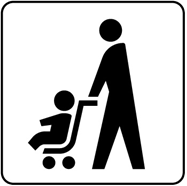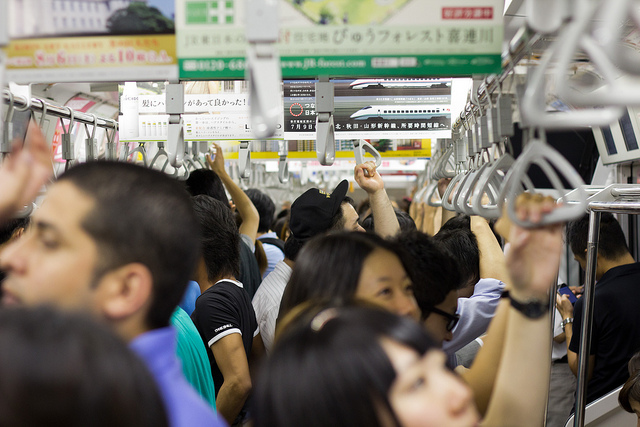Public transportation in Japan can be very crowded, especially in big cities like Tokyo, so it isn't the easiest place to be for parents pushing a young child in a stroller. With such little space, many have felt obligated to attempt the balancing act of collapsing the stroller and holding their child during the ride.
Now, they don't have to. Japan's Ministry of Land, Infrastructure and Transport has standardized [ja] the rules across its systems to allow strollers on board public transportation without being folded. The ministry has also designated a priority seat for parents, which will be marked with a special sticker.The new rules do still encourage parents to collapse strollers when transit is especially crowded, however.
According to a ministry report [ja] that details the background behind implementing the new rules, there are no statistics available for the use of baby carriages on public transportation. But it is estimated that 1-2 percent of passengers are accompanied by strollers at transport hubs in big cities, a figure 20 to 30 times higher than that of passengers in wheelchairs.
The report also noted that compared to other regions, Tokyo is less comfortable for people with strollers on public transit:

Image published by Japan's Ministry of Land, Infrastructure and Transport. Parents will no longer have to fold strollers when riding on trains and buses.
・混雑時に公共交通機関にベビーカーを折りたたまずに乗車することを不快・迷惑と感じる人の割合が多い。
・ベビーカーで移動する際に公共交通機関を利用する頻度が高いが、その際、車内でベビーカーを折りたたむ割合も比較的高い。
・ベビーカー利用時に周囲の方による手助けが少ない。
- The rate of passengers who feel annoyed by unfolded strollers on crowded transit is higher [in Tokyo]
- People who travel with strollers use public transportation more frequently, and they very frequently tend to fold the strollers on board
- Fewer fellow passengers help baby carriage users
Twitter user yukixxxx explained the general attitude toward parents carrying their babies on public transportation:
ベビーカーたたまず乗車OK 公共交通機関でルール化 http://t.co/s4MRMONKcT TPOをわきまえましょう。はこれまで通りで、とりあえず「たたみなさいよ!」という声に対して国が対応してもらえたのはありがたい。ベビーカーで電車乗ったことないけど。周りの目が怖いから。
— yukixxxxx (@yukixxxxx) 2014, 3月 30
We should continue to bear in mind the time, place and occasion. I appreciate the government taking on this issue while some will continue to say “you should fold the stroller anyway”. Though I've never taken trains with a baby stroller because I am scared how other passengers would look at me.
Responding to the new rules [ja], user meimei commented:
ルール化してもらえるとありがたい。常に場所取ってすいません・・・って気持ちで乗ってたから。ま、満員電車は絶対避けるけどねー。 ベビーカーたたまず乗車OK 公共交通機関でルール化(朝日新聞デジタル) – Y!ニュース http://t.co/85rcbUKDAy
— めえめえ (@meimei_BJ) 2014, 3月 27
I appreciate that they made this a rule. I have always felt sorry for taking up extra space [with a stroller] on a train. I will refrain from taking crowded trains though.
Twitter user Momoko Maeno looked backed on her days of travelling with her baby:
ふむーなるほど、そういう展開に。ベビーカー持って電車に乗るのが嫌で、車か抱っこひもで移動した結果、ベビーカーに乗ってくれない子に育ちましたw ベビーカーたたまず乗車OK 公共交通機関でルール化(朝日新聞デジタル) – Y!ニュース http://t.co/imYM4ZWqT4
— Momoko Maeno (@maemooot) 2014, 3月 27
Hmmm, to see how things have changed nowadays. Back when I was taking care of my baby, I disliked getting on the train with a baby stroller, and I would travel carrying my baby in front with a baby sling. The result is my child grew up to be one of those who refuses to get into a baby stroller. (laughing)
Another user, maguro610, recalled what used to be an unspoken rule among passengers:
良かった!うちはもう子供が18才になるけど、当時は空いてる電車でもたたむのが常識で片手に長女。片手に次女と前にベビーカーで通院も大変だった。RT ベビーカーたたまず乗車OK 公共交通機関でルール化(朝日新聞デジタル) – Y!ニュース http://t.co/bd3NA9i7qQ
— まぐろ(´•.̫ • ⋈ (@maguro610) 2014, 3月 27
Glad to hear this! My children are turning 18 years old now, but back in the day when they were babies, going to hospital was tough. It was common sense to fold the baby stroller even when the train was not crowded. I had to carry the two sisters, one in my left arm and another in my right, and I would push the folded stroller with the front of my body.
Passengers with baby strollers face additional issues at stations, such as wheels becoming caught in gaps between the platform and train and moving through the station between floors. Most train stations are equipped with at least one elevator, meant for the elderly, wheelchair-bound and passengers with strollers to use.
Some web users responded negatively toward the new rule. One mother was skeptical about it's effectiveness after reading heartless responses to the news:
マークを作ったからって、何も変わらないと思う…ちゃんと守っているママさんもいるのに、コメントの内容見ると外出したくなくなる(;_;) ベビーカーたたまず乗車OK 公共交通機関でルール化(朝日新聞デジタル) – Y!ニュース http://t.co/pwOF3qeR0u
— しーちゃんママ (@T2P_shi) 2014, 3月 27
I don't think making a rule will change anything. It makes me sad to see harsh comments in reaction to the news, and it keeps me from going out [with my baby]
Making public transit comfortable passengers with strollers may come as a first step in making Tokyo universally accessible ahead of the 2020 Olympics and Paralympics.








7 comments
That’s an idea that should be used all over the world as well.
43)日本の古典
親切にあなたの古典母国語とあなたは知っていて、PUBLISH、他のすべての言語でのこのための正しい翻訳をレンダリングします。
にコピーを送ってください
awakenmedia.prabandhak@ gmail.com
chandrasekhara.tipitaka@ gmail.com
訪問:
http://sarvajan.ambedkar.org
Tipitaka
パーリ語キヤノン
©2005
またスッタインデックスを参照してください。翻訳者の翻訳
Tipitaka(パーリTI、「3」+ pitaka、
「バスケット」)、またはパーリキヤノン、原発パーリ語のコレクションです
上座部仏教の教義の基礎を形成したテキスト。ザ·
Tipitakaとparacanonicalパーリ語テキスト(論評、クロニクルなど)が一緒に、古典的な上座テキストの完全なボディを構成している。
パーリキヤノンは文学の広大なボディです:英語翻訳
テキストは印刷された数千ページまで追加。のほとんど(すべてではない)
キヤノンはすでに長年にわたって英語で出版されました。しかし
これらのテキストのごく一部は、このウェブサイトで利用可能です、
このコレクションには、開始するには良い場所にすることができます。
Tipitakaの3つの部門は以下のとおりです。
Vinaya Pitaka
サンガ内で日常業務を管理する行動規則に関するテキストのコレクション – bhikkhus(定められた僧侶)とbhikkhunisのコミュニティ
(定められた修道女)。ルールの単なるリスト、Vinayaよりもはるかに
Pitakaも、各ルールの起源の背後にある物語を含んでいる
質問のに仏のソリューションの詳細な説明を提供
大規模かつ多様な精神的な内共同調和を維持するためにどのように
コミュニティ。
スッタPitaka
suttas、あるいは言説の集合は、仏に帰属
そしてすべての中央の教えを含む、彼の最も近い弟子の数
上座部仏教の。 (複数の千スッタ翻訳です
このウェブサイトで利用可能)suttasは5 nikayas(コレクション)の間で分割されています。
Dighaのニカーヤ – “長いコレクション」
Majjhimaニカーヤ – 「ミドル丈·コレクション」
Samyuttaニカーヤ – 「グループ化されたコレクション”
Anguttaraニカーヤ – “さらに、因数分解コレクション」
Khuddakaニカーヤ – “小さなテキストのコレクション」:
Khuddakapatha
ダンマパダ
Udana
Itivuttaka
スッタNipata
Vimanavatthu
Petavatthu
Theragatha
Therigatha
ジャータカ
Niddesa
Patisambhidamagga
Apadana
Buddhavamsa
Cariyapitaka
Nettippakarana(のみTipitakaのビルマ語版に含まれています)
Petakopadesa(””)
Milindapañha(””)
Abhidhamma Pitaka
テキストのコレクションここで基本的な教義上の原則
スッタPitakaで提示を手直しし、に再編成される
の調査に適用することができ、系統的なフレームワーク
心と物質の性質。
さらに読書のため
どこで完全パーリキヤノン(Tipitaka)のコピーを入手できますか? (よくある質問)
Tipitakaを越えて:ポスト正規パーリ語文献へのフィールドガイド
パーリ語語学エイズがあらゆるレベルのパーリ語の学生に有用であろうリンクを提供しています。
Somapala Jayawardhanaによるパーリ語文学のハンドブック、
(コロンボ:Karunaratne&サンズ社、1994年)。ガイド、辞書
主な説明の詳細、パーリキヤノンを通じて、形成
キヤノンでのランドマーク。
パーリキヤノンの分析、ラッセル·ウェッブ、エド。 (キャンディ:
仏教出版協会、1975)。不可欠な「ロードマップ」と
パーリキヤノンの概要。でsuttasをリスト優れたインデックスが含まれています
名前を付けます。
Tipitaka、Uコ·レイ編のご案内。 (デリー:スリランカSatguru
出版物、1990)。 Tipitakaのもう一つの優れた概要、
多くの重要なsuttasの要約を含む。
仏教辞典、Nyanatiloka Mahathera(キャンディで:
仏教出版協会、1980)。重要なの古典的なハンドブック
上座部仏教の用語と概念。
43) Classical Japanese
KINDLY RENDER CORRECT TRANSLATION TO THIS IN YOUR CLASSICAL MOTHER TONGUE AND ALL THE OTHER LANGUAGES YOU KNOW AND PUBLISH.
Please send a copy to
awakenmedia.prabandhak@gmail.com
chandrasekhara.tipitaka@gmail.com
Visit:
http://sarvajan.ambedkar.org
Tipitaka
The Pali Canon
© 2005
See also Sutta Index; Translations by Translator
The Tipitaka (Pali ti, “three,” + pitaka,
“baskets”), or Pali canon, is the collection of primary Pali language
texts which form the doctrinal foundation of Theravada Buddhism. The
Tipitaka and the paracanonical Pali texts (commentaries, chronicles, etc.) together constitute the complete body of classical Theravada texts.
The Pali canon is a vast body of literature: in English translation
the texts add up to thousands of printed pages. Most (but not all) of
the Canon has already been published in English over the years. Although
only a small fraction of these texts are available on this website,
this collection can be a good place to start.
The three divisions of the Tipitaka are:
Vinaya Pitaka
The collection of texts concerning the rules of conduct governing the daily affairs within the Sangha — the community of bhikkhus (ordained monks) and bhikkhunis
(ordained nuns). Far more than merely a list of rules, the Vinaya
Pitaka also includes the stories behind the origin of each rule,
providing a detailed account of the Buddha’s solution to the question of
how to maintain communal harmony within a large and diverse spiritual
community.
Sutta Pitaka
The collection of suttas, or discourses, attributed to the Buddha
and a few of his closest disciples, containing all the central teachings
of Theravada Buddhism. (More than one thousand sutta translations are
available on this website.) The suttas are divided among five nikayas (collections):
Digha Nikaya — the “long collection”
Majjhima Nikaya — the “middle-length collection”
Samyutta Nikaya — the “grouped collection”
Anguttara Nikaya — the “further-factored collection”
Khuddaka Nikaya — the “collection of little texts”:
Khuddakapatha
Dhammapada
Udana
Itivuttaka
Sutta Nipata
Vimanavatthu
Petavatthu
Theragatha
Therigatha
Jataka
Niddesa
Patisambhidamagga
Apadana
Buddhavamsa
Cariyapitaka
Nettippakarana (included only in the Burmese edition of the Tipitaka)
Petakopadesa ( ” ” )
Milindapañha ( ” ” )
Abhidhamma Pitaka
The collection of texts in which the underlying doctrinal principles
presented in the Sutta Pitaka are reworked and reorganized into a
systematic framework that can be applied to an investigation into the
nature of mind and matter.
For further reading
Where can I find a copy of the complete Pali canon (Tipitaka)? (Frequently Asked Question)
Beyond the Tipitaka: A Field Guide to Post-canonical Pali Literature
Pali Language Study Aids offers links that may be useful to Pali students of every level.
Handbook of Pali Literature, by Somapala Jayawardhana
(Colombo: Karunaratne & Sons, Ltd., 1994). A guide, in dictionary
form, through the Pali canon, with detailed descriptions of the major
landmarks in the Canon.
An Analysis of the Pali Canon, Russell Webb, ed. (Kandy:
Buddhist Publication Society, 1975). An indispensable “roadmap” and
outline of the Pali canon. Contains an excellent index listing suttas by
name.
Guide to Tipitaka, U Ko Lay, ed. (Delhi: Sri Satguru
Publications, 1990). Another excellent outline of the Tipitaka,
containing summaries of many important suttas.
Buddhist Dictionary, by Nyanatiloka Mahathera (Kandy:
Buddhist Publication Society, 1980). A classic handbook of important
terms and concepts in Theravada Buddhism.
43) Classical Japanese
FREE ONLINE E-Nālanda Research and Practice UNIVERSITY
TIPITAKA
TIPITAKA AND TWELVE DIVISIONS
Brief historical background
Sutta Pitaka
Vinaya Pitaka
Abhidhamma Pitaka
Twelve Divisions of Buddhist Canons
Nine Divisions of Buddhist Canons
http://oupeltglobalblog.com/2014/06/19/promoting-speaking-in-the-mixed-ability-classroom/#comment-40385
share this in FACE BOOK
Dīgha Nikāya
[dīgha:
long] The Dīgha Nikāya gathers 34 of the longest discourses given by
the Buddha. There are various hints that many of them are late additions
to the original corpus and of questionable authenticity.
Sutta Piṭaka
— The basket of discourses —
[ sutta: discourse ]
Dīgha Nikāya
DN 9 –
Poṭṭhapāda Sutta
{excerpt}
— The questions of Poṭṭhapāda —
Tree
Sutta Piṭaka
— The basket of discourses —
[ sutta: discourse ]
The Sutta Piṭaka contains the essence of the Buddha’s teaching
regarding the Dhamma. It contains more than ten thousand suttas. It is
divided in five collections called Nikāyas.
Dīgha Nikāya
[dīgha: long] The Dīgha Nikāya gathers 34 of the longest
discourses given by the Buddha. There are various hints that many of
them are late additions to the original corpus and of questionable
authenticity.
Tree Sutta Piṭaka >> Digha Nikāya
DN 9 –
Poṭṭhapāda Sutta
{excerpt}
— The questions of Poṭṭhapāda —
Now, lord, does perception arise first, and knowledge after; or does
knowledge arise first, and perception after; or do perception &
knowledge arise simultaneously?
Potthapada,
perception arises first, and knowledge after. And the
arising of knowledge comes from the arising of perception. One discerns,
‘It’s in dependence on this that my knowledge has arisen.’ Through this
line of reasoning one can realize how perception arises first, and
knowledge after, and how the arising of knowledge comes from the arising
of perception
TWEET:one can realize how perception arises first, and knowledge after, and how the arising of knowledge comes from the arising of perception
https://www.youtube.com/watch?v=RblJLKC-V8M
Digha Nikaya 9 Pottapada Sutta – About States of Consciousness Part 11:320:12 hrs
https://www.youtube.com/watch?v=QGuGRdBqWc8
Digha Nikaya 9 Potthapada Sutta – States of Consciousness Part 21:125:07 hrs
http://www.yourepeat.com/watch/?v=l7N4fAqtijg
Singithi Daham Mihira Cincinnati, Ohio United States 2012 1:49:11hr
http://www.yourepeat.com/watch/?v=lAlGT0QUozY
1. Maha Piritha – Ven Wattala Seelarathana Thero 58:58 mins
http://www.yourepeat.com/watch/?v=86u0ojUotho
Samdech Huot Tat ធម៌នមស្ការ Namaskar and taking Eight Precepts 22:27 mins
https://www.youtube.com/watch?v=Tkw6H1u4rZY
How to Make Objects Facebook-Friendly : Social Media Help 2:09min
Making objects Facebook-friendly is a great way to make things easier on your audience. Make objects Facebook-friendly with help from a Los Angeles-based social media manager and brand designer in this free video clip.
Expert: Phil Pallen
Filmmaker: John Wilbers
Series Description: Social media is a powerful tool that you can use to easily connect yourself with nearly anyone else on the planet. Get tips on using social media with help from a Los Angeles-based social media manager and brand designer in this free video series.
43)日本の古典
無料オンライン電子ナーランダ研究と実践大学
TIPITAKA
TIPITAKA十二DIVISIONS
簡単な歴史的背景
スッタPitaka
Vinaya Pitaka
Abhidhamma Pitaka
仏教参事の十二部門
仏教参事の9部門
http://oupeltglobalblog.com/2014/06/19/promoting-speaking-in-the-mixed-ability-classroom/#comment-40385
フェイスブックでこれを共有する
Dighaのニカーヤ
[Dighaの:
ロング] Dighaのニカーヤはによって与えられた最長の言説の34を収集し
仏。様々なヒントが、それらの多くは遅れて追加していることがあります
オリジナルのコーパスへと疑わしい真正性。
スッタPiṭaka
– 言説のバスケット –
[スッタ:談話]
Dighaのニカーヤ
DN9 –
Poṭṭhapādaスッタ
{抜粋}
– Poṭṭhapādaの質問 –
ツリー
スッタPiṭaka
– 言説のバスケット –
[スッタ:談話]
スッタPiṭakaは仏陀の教えのエッセンスが含まれています
ダンマについて。それ以上の1万suttasが含まれています。それは
Nikāyasと呼ばれる5コレクションに分割されている。
Dighaのニカーヤ
[Dighaの:ロング] Dighaのニカーヤは最長の34を収集し
仏で与え言説。様々なヒントがあることに、多くの
彼らは元のコーパスへと疑わしいの後期追加です
信憑性。
ツリースッタPiṭaka>> Dighaのニカーヤ
DN9 –
Poṭṭhapādaスッタ
{抜粋}
– Poṭṭhapādaの質問 –
今、主は、認識がまず発生し、知識の後にありません;またはしない
知識は最初に生じ、認識後;または認知&を行う
知識が同時に起こる?
Potthapada、
認識がまず発生し、知識の後。と
知識を生じることは知覚の生じるから来ている。一つは、洞察し
「それは私の知識が生じていることを、このに依存します。’これによって
推論1のラインは、知覚が最初に発生したどのように実現し、することができます
後の知識、そしてどのように知識を生じるが生じたから来て
知覚の
TWEET:1の認識がまず発生する方法を理解することができ、知識の後、どのように知識を生じるには、知覚の生じるから来ている
https://www.youtube.com/watch?v=RblJLKC-V8M
Dighaのニカーヤ9 Pottapadaスッタ – 意識パーツの状態11:320:12時間について
https://www.youtube.com/watch?v=QGuGRdBqWc8
Dighaのニカーヤ9 Potthapadaスッタ – 意識パーツの状態21:125:07時間
http://www.yourepeat.com/watch/?v=l7N4fAqtijg
Singithi Daham三平オハイオ州シンシナティ、米国2012年1時49分11秒の時間
http://www.yourepeat.com/watch/?v=lAlGT0QUozY
1マハPiritha – ヴェンWattalaのSeelarathana Thero58:58分
http://www.yourepeat.com/watch/?v=86u0ojUotho
フンHuotタットធម៌នមស្ការ太陽礼拝と8つの教訓午前22時27分を取って
https://www.youtube.com/watch?v=Tkw6H1u4rZY
ソーシャルメディアヘルプ午前2時09分:作り方は、フェイスブックにやさしいのオブジェクト
Facebookのフレンドリーなオブジェクトを作ることはあなたの聴衆に物事を簡単にするための素晴らしい方法です。するオブジェクトのFacebookにやさしいこの無料のビデオクリップでのロサンゼルスベースのソーシャルメディア·マネージャとブランドのデザイナーからの助けを借りて。
専門家:フィル·Pallen
映画監督:ジョン·Wilbers
シリーズ概要:ソーシャルメディアを使用すると、簡単に地球上の他のほとんど誰と自分を接続するために使用できる強力なツールです。この無料のビデオシリーズのロサンゼルスベースのソーシャルメディア·マネージャとブランドのデザイナーからの助けを借りて、ソーシャルメディアを使用する方法のヒントを得る。